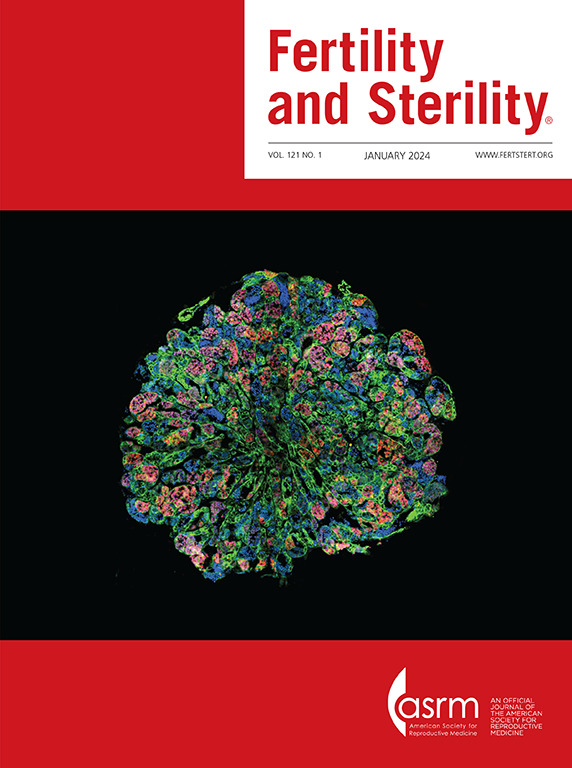体力活动和压力对冷冻胚胎移植周期的影响:步骤和压力跟踪估计妊娠(步骤)试验。
IF 7
1区 医学
Q1 OBSTETRICS & GYNECOLOGY
引用次数: 0
摘要
目的探讨客观测量的体力活动和应激对程序化激素替代疗法(HRT)冷冻胚胎移植(FET)结果的影响。设计:观察性队列研究对象:在单一学术中心接受标准HRT FET治疗的患者。由FitBit Charge 5可穿戴活动追踪器测量的FET前后的平均每日步数。主要观察指标:这项纵向研究纳入了82名接受HRT FET治疗的女性。每位参与者在FET周期期间都佩戴FitBit Charge 5健康追踪器。跟踪的变量包括每日平均步数、活动区分钟数、每日消耗的卡路里、心率和睡眠时间。参与者还被要求在月经周期开始时完成生育问题清单(FPI),以测量与不孕相关的感知压力。最后,在胚胎移植前2天的3个时间点采集6份唾液皮质醇样本。然后,我们将患者分为两组,分别是通过FET怀孕的患者(n=51)和没有通过FET怀孕的患者(n= 31),并使用学生t检验和泊松回归分析比较FitBit变量和皮质醇水平。结果平均约40天的连续健康数据被收集。当将怀孕者与未怀孕者进行比较时,在整个研究期间平均每日步数没有差异,也没有胚胎移植前后的差异。活动区分钟、每日心率、每日卡路里消耗和睡眠时间在胚胎移植前后两组之间没有差异。两组之间唤醒皮质醇、唤醒后30分钟皮质醇、睡前皮质醇或平均皮质醇唤醒反应没有差异。在比较两组时,FPI测量的感知压力基本相同。在第一批使用可穿戴健康追踪器检查体外受精结果的研究中,体力活动和压力对HRT FET周期的妊娠率没有影响。本文章由计算机程序翻译,如有差异,请以英文原文为准。
THE IMPACT OF PHYSICAL ACTIVITY AND STRESS ON FROZEN EMBRYO TRANSFER CYCLES: THE STEP AND STRESS TRACKING TO ESTIMATE PREGNANCY (SSTEP) TRIAL.
OBJECTIVE
To investigate the impact of objectively measured physical activity and stress on programmed hormone replacement therapy (HRT) frozen embryo transfer (FET) outcomes.
DESIGN
Observational cohort study SUBJECTS: Patients undergoing standard HRT FET at a single academic center.
EXPOSURE
Average daily step counts before and after FET as measured by FitBit Charge 5 wearable activity tracker.
MAIN OUTCOME MEASURES
This longitudinal study involved 82 women undergoing a programmed HRT FET. Each participant wore a FitBit Charge 5 health tracker for the duration of their FET cycle. Variables tracked included daily average steps, activity zone minutes, daily calories burned, heart rate, and sleep duration. Participants were also asked to complete the Fertility Problem Inventory (FPI) at the start of their cycle to measure infertility-related perceived stress. Lastly, 6 salivary cortisol samples were obtained at three time points two days before embryo transfer. We then divided patients into 2 groups by those who conceived a pregnancy from the FET (n=51) versus those who did not (N=31) and compared FitBit variables and cortisol levels using Students t-tests and Poisson regression analysis.
RESULTS
On average, approximately 40 days of continuous health data was collected from subjects. When comparing those who conceived a pregnancy versus those who did not, there were no differences in average daily steps for the full study period, nor pre- or post- embryo transfer. Activity zone minutes, daily heart rate, daily calories burned, and sleep duration did not differ between the two groups pre- and post- embryo transfer. There was no difference in awakening cortisol, 30-minute post awaking cortisol, bedtime cortisol, or average cortisol awakening response between the two groups. Perceived stress measured by the FPI was largely the same when comparing the 2 groups.
CONCLUSIONS
In one of the first studies using wearable health trackers to examine in vitro fertilization outcomes, physical activity and stress did not influence the pregnancy rate in programmed HRT FET cycles.
求助全文
通过发布文献求助,成功后即可免费获取论文全文。
去求助
来源期刊

Fertility and sterility
医学-妇产科学
CiteScore
11.30
自引率
6.00%
发文量
1446
审稿时长
31 days
期刊介绍:
Fertility and Sterility® is an international journal for obstetricians, gynecologists, reproductive endocrinologists, urologists, basic scientists and others who treat and investigate problems of infertility and human reproductive disorders. The journal publishes juried original scientific articles in clinical and laboratory research relevant to reproductive endocrinology, urology, andrology, physiology, immunology, genetics, contraception, and menopause. Fertility and Sterility® encourages and supports meaningful basic and clinical research, and facilitates and promotes excellence in professional education, in the field of reproductive medicine.
 求助内容:
求助内容: 应助结果提醒方式:
应助结果提醒方式:


